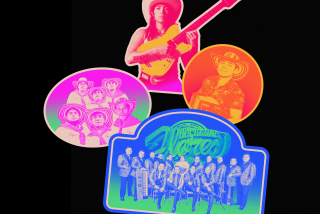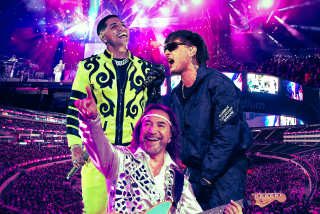La Santa Cecilia is an L.A. story
Before she morphed into the ruby-lipped, hip-shaking diva La Marisoul, Marisol Hernandez lived in alternate musical realities as an L.A. teenager.
She spent weekends among the tourist emporiums of Olvera Street, where her grandfather owned a shop, singing traditional Mexican boleros for spare change. Then, during the week, as a Hollywood High School student, Hernandez says, “I would dress in black, I was all about the Doors and the Beatles, and I was all dark. It was like two different lives.”
Those who’ve attended a Levitt Pavilion concert in MacArthur Park lately, or thrashed among the Dionysian throngs at the Mucho Mas musical bacchanals at La Cita, would quickly grasp that Hernandez ultimately united her creative personas. Now the torchy belter of misty-eyed rancheras coexists on-stage with the popster who lays down a charming, irony-free Spanish-language cover of “Strawberry Fields Forever.”
The same could be said of La Santa Cecilia, the ebullient sextet that La Marisoul fronts as lead singer, with her oversize gift for personal fashion statements and a voice that puts some listeners in mind of a bilingual, less angst-ridden Janis Joplin with its bluesy, lusty forthrightness.
Like any number of older-sibling L.A. bands of Chicano pedigree — Ollin, Quetzal, Quinto Sol — La Santa Cecilia crafts music that is both anchored by regional influences and well-traveled. In the trans-border world of contemporary rock and pop, mariachi trumpets joust with Stax-style horns, East L.A. tough guys weep over Morrissey’s despairing passion plays and digitally enhanced accordions lure dancers onto the floor as relentlessly as a disco beat.
La Santa Cecilia hails from that milieu, and after years of attracting passionate followers across California and the Southwest with its dance-ready aural montages of cumbia, funk, punk, samba, son jarocho and klezmer, the band seems eager to make the leap from hardworking subculture icons to headliner status.
Between Labor Day and mid-October, the band named for the patron saint of musicians — whose other members are guitarist Gloria Estrada, accordion and requinto player Jose “Pepe” Carlos, bassist Alex Bendaña, percussionist Miguel Ramirez and drummer Hugo Vargas — will play gigs at the Los Angeles County Museum of Art, the Fairmont Hotel in San Jose, the International Accordion Festival in San Antonio, and their first New York dates, at El Museo Del Barrio and Joe’s Pub.
The band’s Latin-alternative music has been gaining traction elsewhere. It has a recent EP to promote, and its bouncy-melancholic song “Chicle” turned up on an episode of the Showtime series “Weeds” and spun off a video that would win the MTV Cuteness Award, if such a thing existed, with children appearing as the band members’ doppelgangers.
La Santa Cecilia’s energy and authenticity have been earning props from previous-generation East L.A. and Boyle Heights bands who know how hard it can be to break out when you don’t fit the cookie-cutter templates of mainstream Latin radio. “They’re inspiring people, they really are,” says Scott Rodarte of Ollin, which has shared a concert bill with La Santa Cecilia. “With every show they’re getting stronger.”
The band came together through concentric friendships. Marisoul and Carlos met while playing on Olvera Street. Marisoul and Estrada then crossed paths through a percussionist mutual friend at a party and started “dating musically,” as Estrada puts it. Estrada had known Vargas and Bendaña during her student years at Pasadena City College and Cal State L.A.
As mostly native Southern Californians (Carlos was born in Oaxaca), the group’s members, all of whom are in their late 20s or early 30s, grew up thinking it was perfectly natural to hear and perform music in two languages, from mariachi to jazz.
Estrada remembers hearing musicians at Mariachi Plaza while growing up in Boyle Heights, as well as the neighborhood’s backyard parties. “I used to just go to backyard punk rock shows, in Boyle Heights, because they used to have them all the time and I couldn’t afford to go to a club,” she says. “Backyard gig, $3. Then the cops would come like an hour later.”
Ramirez fondly recalls childhood outings to Tijuana when his family would dine at traditional restaurants to the sounds of live musical trios. “Then when I was like 12 and 13 and my brother was like, ‘Hey, listen to this,’ and it was like Rush, Led Zeppelin and Santana, Bob Marley, and I was like stuck in the room listening to that all day,” he says.
“And at some point this all came together and they both started intermingling and formed our identity.”
More to Read
The biggest entertainment stories
Get our big stories about Hollywood, film, television, music, arts, culture and more right in your inbox as soon as they publish.
You may occasionally receive promotional content from the Los Angeles Times.











